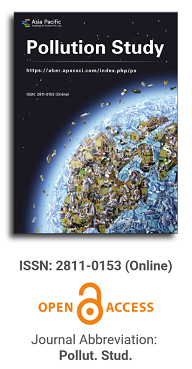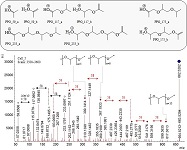
Asia Pacific Academy of Science Pte. Ltd. (APACSCI) specializes in international journal publishing. APACSCI adopts the open access publishing model and provides an important communication bridge for academic groups whose interest fields include engineering, technology, medicine, computer, mathematics, agriculture and forestry, and environment.

The (partial) replacement of synthetic polymers with bioplastics is due to increased production of conventional packaging plastics causing for severe environmental pollution with plastics waste. The bioplastics, however, represent complex mixtures of known and unknown (bio)polymers, fillers, plasticizers, stabilizers, flame retardant, pigments, antioxidants, hydrophobic polymers such as poly(lactic acid), polyethylene, polyesters, glycol, or poly(butylene succinate), and little is known of their chemical safety for both the environment and the human health. Polymerization reactions of bioplastics can produce no intentionally added chemicals to the bulk material, which could be toxic, as well. When polymers are used to food packing, then the latter chemicals could also migrate from the polymer to food. This fact compromises the safety for consumers, as well. The scarce data on chemical safety of bioplastics makes a gap in knowledge of their toxicity to humans and environment. Thus, development of exact analytical protocols for determining chemicals of bioplastics in environmental and food samples as well as packing polymers can only provide warrant for reliable conclusive evidence of their safety for both the human health and the environment. The task is compulsory according to legislation Directives valid to environmental protection, food control, and assessment of the risk to human health. The quantitative and structural determination of analytes is primary research task of analysis of polymers. The methods of mass spectrometry are fruitfully used for these purposes. Methodological development of exact analytical mass spectrometric tools for reliable structural analysis of bioplastics only guarantees their safety, efficacy, and quality to both humans and environment. This study, first, highlights innovative stochastic dynamics equations processing exactly mass spectrometric measurands and, thus, producing exact analyte quantification and 3D molecular and electronic structural analyses. There are determined synthetic polymers such as poly(ethylenglycol), poly(propylene glycol), and polyisoprene as well as biopolymers in bags for foodstuffs made from renewable cellulose and starch, and containing, in total within the 20,416–17,495 chemicals per sample of the composite biopolymers. Advantages of complementary employment in mass spectrometric methods and Fourier transform infrared spectroscopy is highlighted. The study utilizes ultra-high resolution electrospray ionization mass spectrometric and Fourier transform infrared spectroscopic data on biodegradable plastics bags for foodstuffs; high accuracy quantum chemical static methods, molecular dynamics; and chemometrics. There is achieved method performance |r| = 0.99981 determining poly(propylene glycol) in bag for foodstuff containing 20,416 species and using stochastic dynamics mass spectrometric formulas. The results highlight their great capability and applicability to the analytical science as well as relevance to both the fundamental research and to the industry.
Volume 6 Issue 1 highlights solution-driven research addressing pollution in developing contexts. It explores developing practical remediation frameworks (like sustainable adsorption for wastewater and mycoremediation kinetics for petroleum) and improving pollution tracking/accountability (metal tracing, unattributable oil spills), among which soil health is the focus. These articles collectively offer actionable insights for global environmental management challenges.
Issue release: 31 March 2025
This study investigated the influence of quarry operations on soil health by evaluating the metal pollution status of soils around major quarry communities (Awi and Njagachan) in Akamkpa, Nigeria. Soil samples were subjected to wet digestion and quantified using an Atomic Absorption Spectrophotometer (Model AA-6800, Japan). The concentrations of lead (63.34–96.34 mg/kg), cadmium (4.29–7.40 mg/kg), mercury (2.34–3.76 mg/kg), arsenic (2.48–5.21 mg/kg), and selenium (1.22–2.75 mg/kg) were all below the U.S. Environmental Protection Agency (US-EPA), Dutch remediation levels, and other soil guidelines. However, significant spatial variation in metal levels across quarry sites points to anthropogenic influences, with quarries likely contributing to the elevated metal concentrations. Contamination factors indicated moderate contamination by lead, considerable contamination by cadmium, and very high contamination by mercury. The degree of contamination was high for all quarries except Ding Zing quarry, which showed a very high degree during the wet season. Ecological risk assessment revealed low potential risk from lead and arsenic, moderate to high risk from cadmium, and very high risk from mercury. Geo-accumulation indices suggested that soils were largely unpolluted by lead and arsenic but ranged from unpolluted to moderately polluted by cadmium and mercury. The study concludes that quarry activities contribute to elevated metal concentrations, posing varying levels of ecological risk. Continuous monitoring is strongly recommended to prevent potential long-term human and environmental health risks, with a focus on addressing mercury contamination. Regulatory measures should be enforced to mitigate further pollution.
Issue release: 31 March 2025
Water pollution has become a major challenge for many low-income and developing countries, leading to a shortage of clean water for daily activities. The review section of this study merges findings from different studies on wastewater treatment, which explored various techniques categorized primarily into physical, biological, and chemical methods. Among these, adsorption—a physical method was identified as the most cost-effective and environmentally friendly approach, primarily because the materials needed for it are widely available in nature. A major gap observed in all the studies reviewed was the lack of the application of the adsorption technique on an industrial scale, which stems mainly from the absence of standardization, as the study reveals. To bridge this gap, we develop a standardized framework for adsorption techniques in small and medium industries with clear guidelines on how to implement adsorption-based wastewater treatment. It incorporates sustainable practices, climate change considerations, and water risk management to ensure long-term environmental and economic benefits.
Issue release: 31 March 2025
Commercially available Total Petroleum Hydrocarbons (TPHs) standards have been widely used for instrumental analysis of TPHs in soils and other environmental matrices. However, there are concerns about the universality of these standards developed in one region of the world to reliably estimate TPHs in environmental matrices in other regions, which prompted this investigation. TPHs standards were prepared from contaminating crude oils at polluted sites at Tibshelf, UK, and Ogoniland, Niger Delta, Nigeria. The prepared standards were used in comparison with some commercially available TPHs standards (TPHs-gasoline diesel range and TPHs C10-C40) for assessment of TPHs levels in the contaminated soil samples treated for phyto and myco-remediation. Results obtained revealed significant differences in the quantification of TPHs between these standards. The TPHs standards prepared from the contaminating crude oils estimated higher levels of TPHs in the soil samples compared to those of the commercially available standards. In assessing the % of TPHs reduction in the remediation experiment, all the standards provided similar estimations of TPHs reduction, with no significant differences. The result revealed that although all the TPHs standards provided consistent evaluation of TPHs remediation in all cases, the commercially available TPHs standards may underestimate the concentration of TPHs in certain environments during pollution incidents. Therefore, with respect to toxicological evaluations, there is a need for TPHs standards specifically developed for a region of interest to be used. This study offers a good insight on how such standards can be prepared.
Issue release: 31 March 2025
The high prospect of mycoremediation and the lingering issues of Total Petroleum Hydrocarbons (TPHs), associated with crude oil pollution in Ogoniland, Niger Delta, Nigeria, necessitate investigations for sustainable remediation options. Therefore, mycoremediation of different contaminated soils (clayey, sandy, and loamy) and sediments collected within the study area was carried out using Pleurotus ostreatus and fermented palm wine, both optimized with Tween 80, for a period of 90 days. Results revealed variation in soils and sediments TPHs content, in the range of 120 to 525 g/kg dry soil (about 12% to 50% of TPHs contamination), which far exceeded the soil threshold value of 10 g/kg dry soil or 1%. Also, the TPHs concentrations in the soils and sediments, and the remediation efficiency were directly related to the textural properties, with the highest TPHs concentrations in clayey soils and the highest remediation efficiencies in loamy soils. Both mycoremediation agents, enhanced with Tween 80, achieved TPHs remediation above 98% in all the treatments (except in sandy soil). In all cases, the mycoremediation proceeded via pseudo second-order kinetics, and the removal rates peaked at 45–75 days. The kinetic insights also establish the initial TPHs concentration as one of the key factors influencing the remediation efficiency. This study further revealed that mycoremediation of TPHs works best in loamy soils; therefore, shifting soil properties towards those of loamy during mycoremediation is highly recommended. Consequently, with the abundant mycoremediation resources in the Niger Delta, mycoremediation can provide a sustainable option in the clean-up of the petroleum-contaminated soils and sediments.
Issue release: 31 March 2025
Oil pollution is one of the most conspicuous forms of damage to the marine environment. It can be divided into two categories: large-scale and small-scale spills. Considerable research has been conducted on large-scale spills, including investigations into the damage caused, the methods of remediation employed, the compensation paid, and the reasons for a sharp decrease in the number of major oil spills during the last 20 years. However, very little attention has been paid to small-scale spills, leaving largely unresearched the reasons for their continued occurrence, the damage they cause, and the lack of compensation paid out for them. Because the number of large-scale marine oil spills has greatly reduced in recent years, there may be a perception that the problem of marine oil spills has been broadly brought under control. However, this would be to ignore the issue of small-scale spills, which have not decreased and are causing severe problems in coastal areas. The perpetrators of these small-scale spills are very difficult to identify, so they invariably escape detection and thereby avoid having to pay for the clean-up and damages costs caused by their actions. The main aim of this review paper is to draw attention to the lack of research into this unsatisfactory situation. The paper describes the scale and type of damage caused by small-scale spills; analyzes the problem of identifying unattributable polluters; considers ways of remediating oil spills; and evaluates current procedures for obtaining compensation for clean-up operations. Given the escalating frequency of these small-scale spills and their profound impact on marine ecosystems and vulnerable communities, it is imperative that researchers, policymakers, and stakeholders prioritize the development of effective strategies to address this pressing issue. The time to act is now, as the health of our coastlines and the livelihoods of countless individuals depend on our ability to confront the challenges posed by small-scale oil spills.
Issue release: 31 March 2025
This study presents an extended bibliometric analysis to identify the research landscape, trends, and influential aspects in the field of air pollution and environmental impacts. This study aims to explore the existing gaps and emerging trends in the research landscape on air pollution and its environmental impacts by analyzing publication records, author analysis, country analysis, keywords analysis and thematic maps. The findings expose the increasing interest in air pollution and its environmental impacts worldwide, growing research output, key contributors, and influential knowledge hubs that are in the process of shaping this field of study. Bibliometric techniques, like keyword co-occurrence and thematic mapping, unravel the intellectual structure and evolving focal areas within this research domain. The main findings reveal a number of highly frequent keywords that describe the interdisciplinary nature of air pollution and environmental impact studies. Thematic mapping highlights the following major themes: “air”, “climate” and “pollution”, while emerging themes in research involve “emission”, “biomass” and “factors”, etc. The study gives useful insights for future studies and informed decision-making in the industry with a better understanding of the status quo in air pollution and its environmental impacts research. Future research efforts are recommended to be directed toward more interdisciplinary approaches, strengthened regional studies in developing countries, and the promotion of international collaborations in order to meet air pollution and its environmental consequence challenges effectively on a global scale.
.jpg)
Beijing University of Technology, China




 Open Access
Open Access